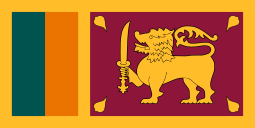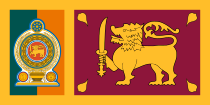
Back Vlag van Sri Lanka Afrikaans علم سريلانكا Arabic علم سريلانكا ARZ Bandera de Sri Lanka AST Şri-Lanka bayrağı Azerbaijani Сцяг Шры-Ланкі Byelorussian Национално знаме на Шри Ланка Bulgarian শ্রীলঙ্কার জাতীয় পতাকা Bengali/Bangla শ্রীলঙ্কার ফিরালহান BPY Zastava Šri Lanke BS
 | |
| Sinha Flag Lion Flag | |
| Use | Civil and state flag, civil ensign |
|---|---|
| Proportion | 1:2 |
| Adopted | 22 May 1972 |
| Design | A golden field with two panels: the smaller hoist-side panel has only two vertical bands of teal and orange and the larger fly-side panel is the maroon field depicting the golden lion holding a kastane sword in its right fore paw in the center and four bo tree (bodhi tree) leaves on each corner, and the golden field appears as a border around the entire flag and extends in between the two panels, all bordering together. |
 | |
| Use | Auxiliary ensign used by merchant ship commanded by reserve naval officer |
| Proportion | 1:2 |
| Adopted | 1972 |
| Design | A blue field with the flag of Sri Lanka in the canton. |
 | |
| Use | President's Colour |
| Proportion | 1:2 |
| Adopted | 1972 |
| Design | A defaced flag of Sri Lanka with the Emblem of Sri Lanka |
 | |
| Use | Naval ensign |
| Proportion | 1:2 |
| Adopted | 1972 |
| Design | A white field with the flag of Sri Lanka in the canton. |
 | |
| Use | Civil ensign |
| Proportion | 1:2 |
| Adopted | 1972 |
| Design | A red field with the flag of Sri Lanka in the canton. |
 | |
| Use | Air Force ensign |
| Proportion | 1:2 |
| Adopted | 2010 |
| Design | A defaced sky-blue ensign with the flag of Sri Lanka in the canton and Air Force roundel. |
The flag of Sri Lanka (Sinhala: ශ්රී ලංකාවේ ජාතික කොඩිය, romanized: Sri Lankave jathika kodiya; Tamil: இலங்கையின் தேசியக்கொடி, romanized: Ilankaiyin teciyakkoṭi), also called the Sinha Flag or Lion Flag, consists of a golden lion holding a kastane sword in its right fore-paw in a maroon background with four gold bo leaves, one in each corner. This is bordered by gold, and to its left are two vertical stripes of equal size in teal and orange, with the orange stripe closest to the lion. The lion and the maroon background represent the Sinhalese, while the saffron border and four bo leaves represent the concepts of meththa, karuṇā, muditā and upecka respectively. The stripes represent the country's two largest minorities, with the orange representing the Tamils living in Sri Lanka – both the Sri Lankan Tamils and the Indian Tamils of Sri Lanka – and the green stripe representing the Sri Lankan Moors (Muslims of Sri Lanka). The golden yellow border represents the other minority communities of the country.
© MMXXIII Rich X Search. We shall prevail. All rights reserved. Rich X Search